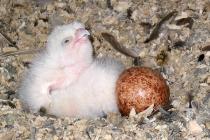
Photo Courtesy of Channel Island National Park
This newborn Peregrine falcon chick was the first to hatch on the Channel Islands since 1940. The falcons are hatching on Santa Barbara Island and are extremely vulnerable to chemicals like DDT and PCB, which can damage their eggs and embryos.
Springtime is here and has brought with it the birth of a couple good-looking chicks - two baby peregrine falcons were discovered last Friday on Santa Barbara Island, the first of their kind to successfully hatch on the island in over 50 years.
Peregrine falcons, which began to disappear from the Channel Islands in the 1940s and ’50s, were placed on the endangered species list in the 1970s. Channel Islands National Park representative Yvonne Menard said the birds have been unsuccessful in reproducing on Santa Barbara Island for decades.
“The last time the peregrine falcons successfully nested was in 1940, and they completely disappeared from the Channel Islands in 1953,” Menard said.
Milena Viljoen, the outreach coordinator from the Montrose Settlements Restoration Program, said the species’ decline was due to the release of Dichloro-Diphenyl-Trichloroethane and polychlorinated biphenyls pesticides produced by a manufacturing plant in the Los Angeles area.
“All the waste products were going into the ocean, forming deposits of chemicals in the sediment, and the contaminants moved through the food web,” Viljoen said.
Falcons ate species that absorbed the chemicals, thus ingesting it themselves.
DDT has taken a serious toll on the falcon population because it impedes the falcons’ ability to lay durable eggs that can withstand incubation, said Viljoen, who is working to restore the falcon population.
“What happens is that the embryo will either dehydrate or the egg shells will break,” Viljoen said.
However, this past Friday, UC Santa Cruz Predatory Bird Research Group team member Brian Latta discovered two successfully hatched baby birds, and one more chick is yet to come.
The recent find is encouraging; Viljoen said she and her colleagues are hopeful that the endangered species will make a comeback in their natural habitat.
“It shows that these birds are moving back into their historical nesting grounds,” she said.
In 1995, when the UC Santa Cruz Predatory Bird Research Group released peregrines all over California, the Montrose Settlements Restoration Program began its attempt to bring back healthy falcon chicks. Janet Linthicum, a staff research associate from the Predatory Bird Research Group, said the falcons were placed into the wild across the state, including the Channel Islands, so they could migrate across California.
“We released them at a fledgling age, and they can move as far as several hundred miles throughout the state,” she said.
The Montrose Settlements Restoration Program recently launched a $250,000 program to examine the Channel Island falcons, a project funded by a $140 million settlement between environmental agencies and the Los Angeles company originally responsible for polluting the ocean with pesticides. The Predatory Bird Research Group is monitoring the DDT levels in the bird eggs to determine whether the falcons’ condition is improving.
“We try and assess the level of contaminants and we are trying to see if the contaminant levels have diminished,” Linthicum said. “As DDT disperses from the environment, the egg shells will slowly improve.”